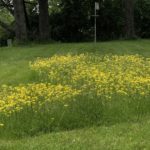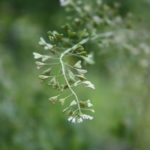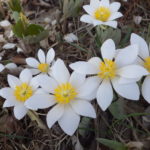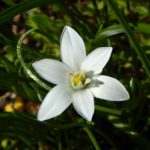Weeds Brighten Our Lawn
Too many people worry about lawn weeds and spend money to buy and spray toxic chemicals. We take a different view. What many call weeds are actually beneficial and we find fascinating. The often-uninvited plants that diversify our lawn connect us with human history, teach us botany, sometimes provide nutrition, and add color to our yard.
We don’t spray or fertilize our lawns at Winding Pathways. The mower gets exercise when grass gets shaggy, but we’re never bothered when new plants show up. Instead, we try to identify them and sometimes mow around them to let them bloom and add color to Winding Pathways.
Here are three “weeds” that we are enjoying this summer for their color:
Hawkweed

Hawkweed is “asexual”.
In mid-spring, a small patch of tiny hawkweed plants was poking through our grass. Rich mowed around them and by late May we enjoyed watching bright yellow hawkweed blooms dance in the sunny breeze.
There are many species of hawkweed. Most are exotic but some are native. Most sport yellow flowers although some can be reddish. Farmers sometimes consider them a weed. Perhaps the most interesting thing about them is their unusual reproduction. They usually spread by seed, but hawkweed seeds aren’t fertilized, meaning that the seed is an exact genetic clone of its parent. They’re asexual!
We’ll enjoy our Hawkweed until their blooms fade and then likely will mow the patch.
Star of Bethlehem
One of our favorite early spring wildflowers is the impressive but delicate bloom of the native Bloodroot. Its pure white petals are showy against the late March or early April ground. A common early summer lawn weed that has a bloodroot-looking flower is the Star of Bethlehem. It’s a lily that is sometimes sold in nurseries. The plant is not native and shows up in our lawn, probably the result of a previous owner planting bulbs years ago. Star of Bethlehem can be invasive, so we enjoy its showy bloom but mow it off before it has a chance to seed. The plant is a perennial and comes up from bulbs each year, so mowing won’t eliminate it but may keep it from seeding.
- Bloodroot is an early spring bloomer. Photo credit Susan Hrobar
- Star of Bethlehem.Six-petaled flower. Pixabay photo
Shepherd’s Purse

Shepherd’s Purse. From Pixabay
An intriguing plant that grows more on the side of the lawn than in the middle is Shepherd’s Purse. Its name comes from the triangular flat fruits that look like a tiny purse. Native to Europe and Asia Minor it may now be the second most common weed worldwide. Shepherd’s Purse has medicinal and food value and may have been deliberately spread by people.
Nature loves diversity. A function of invasive plants is their very nature. Spray a lawn and kill every plant species other than Kentucky Bluegrass and soon “weeds” will move right in. Diversity creates a certain degree of ecological stability, but there’s always change. A fascination of tending a natural unpoisoned lawn is learning to identify new species as they arrive by themselves and watching plant transitions over the years. A common uninvited plant one year may totally disappear the next to be replaced by some new species. Observing is just plain fun that can never be enjoyed by the person who poisons fascinating lawn plants.




All my weeds are wildflowers.(:
Jac